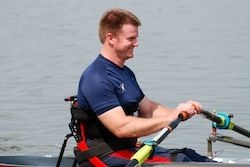As the Paralympics kicks off this week, MIT's contributions to Olympic spirit and accomplishment are up in lights — literally. The London Eye will signal social media sentiment in lights, thanks to an algorithm developed by alumni. This Friday an alumnus hopes to extend his winning streak by competing in an adaptive rowing contest. Read these Slice of MIT blog posts to learn more:
Engineer makes paralysis a "problem to overcome"
In 2001, less than two years after competing in the lightweight doubles at the 2000 Olympic Trials, former MIT rower Ron Harvey '93 was paralyzed from the waist down after a bicycle accident. Yet three months later, he resumed competitive rowing and hasn't stopped. On Friday, Aug. 31, Harvey will compete in the men's adaptive single sculls event at the 2012 Paralympics.
The London Eye feels for you
The London Eye may be the world's largest mood ring. The city's huge Ferris wheel lit up configurations of lights every night of the Olympics — and it starts again tonight through the Paralympics — indicating the day's Twitter sentiment. The algorithm was developed by three MIT alumni, co-founders of Sosolimited, a company that creates interactive installations, applications and live performances. Find out how it works.
Supported by science, Pistorius races in the Olympics
Associate Professor Hugh Herr SM '93 helped South Africa runner Oscar Pistorius become eligible to compete in the Olympics. In 2008, the International Association of Athletics Federations banned Pistorius from competing in able-bodied competitions after tests showed that he expended 25 percent less energy than able-bodied runners. Herr assembled a team of biomechanical experts and successfully appealed to the Court of Arbitration in Sport.
From a pig's bladder to composite microfiber: the evolution of sports equipment
To coincide with the London Olympics, an MIT-collaborated commentary in Nature Materials, "Materials and technology in sport," traces how equipment innovations have impacted sports throughout history. Among the discoveries — the first soccer balls were composed of an outer leather shell and a pig's bladder that served as an air containment unit.
MIT alumni in the Olympics: a brief history
The Institute's Olympic history dates back to Athens in 1896 — the site of the first modern Olympics. According to records compiled by the Alumni Association and DAPER, 25 alumni representing eight countries have competed in 11 sports at 29 summer and winter Olympics
Subscribe to Slice of MIT for daily updates.
Slice of MIT tracks MIT's Olympic and Paralympic connections.
Publication Date:

Caption:
Ron Harvey '93 prepares to compete.
Credits:
Photo courtesy of U.S. Rowing





